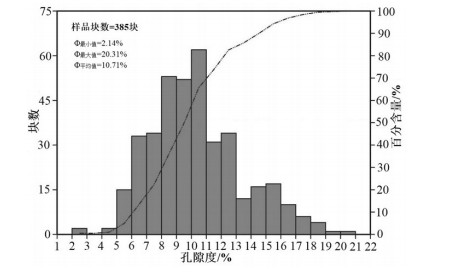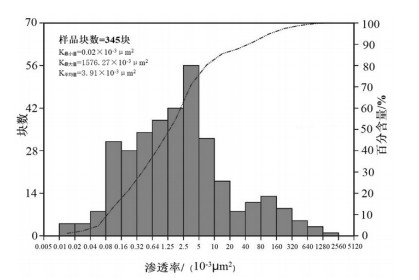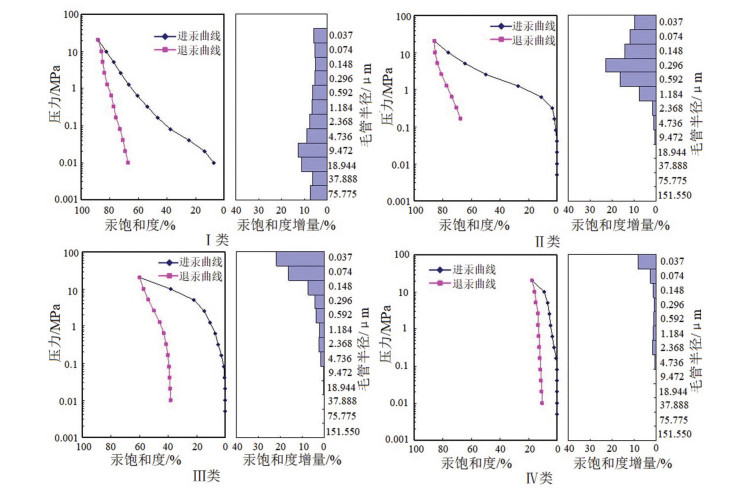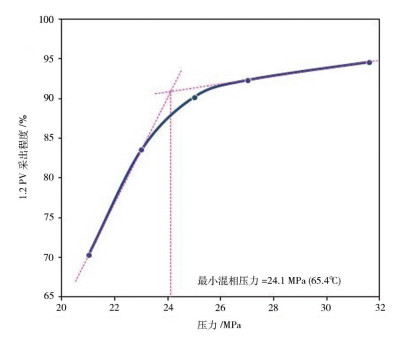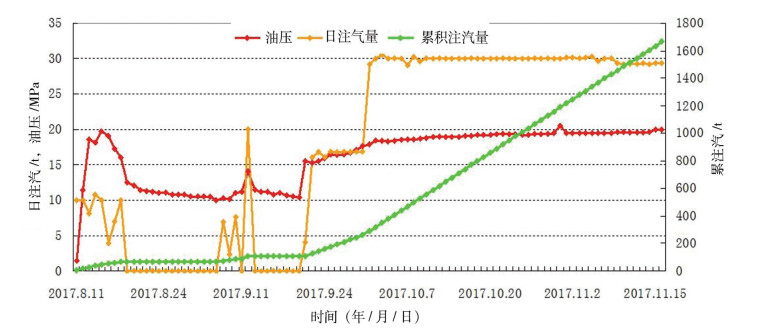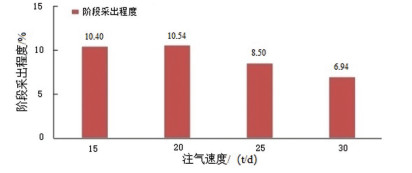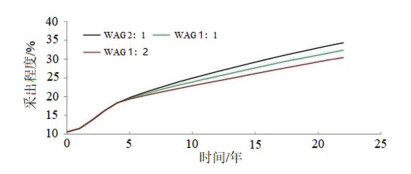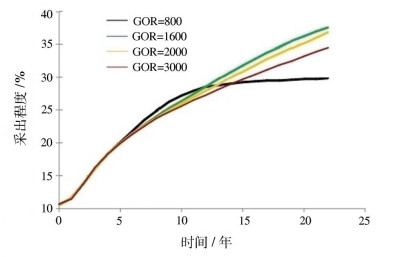Optimum selection of injection-production method for carbon dioxide miscible flooding in low permeability reservoirs: Taking the low-permeability reservoirs of the Kexia Formation in the X zone of the Karamay Oilfield as an example
-
摘要:研究目的
克拉玛依油田X区克下组低渗透油藏存在物性差、水驱开发采收率低等问题,影响了油田的可持续发展。CO2是全球变暖的主要成分,世界各国都在想方设法减少CO2的排放量,本文试图利用CO2驱油气方式提高该油藏的采收率,变害为利。
研究方法文章选取研究区60余口取心井目标层位岩心样品,开展扫描电镜及压汞测试分析等研究,系统梳理储层孔隙结构特征。采用油藏数值模拟方法对CO2连续气驱与CO2水气交替驱参数进行了优选,对比了各种开发方式的驱油效果。
研究结果最后得到了最优的驱油方案: 采用CO2水气交替驱方法,15口井连续注气4年后全部转水气交替注入,气水比为2∶1;气水比10年后调整为1∶1。数值模拟预测,注气开发15年,预测最终采收率将提高30%。
结论通过现场试注结果表明,试采效果注气后产油量较水驱阶段有明显提高,试采效果注气后产油量是水驱阶段的1.85倍,有明显提高,对实现老区稳产和油田可持续发展具有十分重要的意义。
创新点: 通过系统梳理储层孔隙结构特征,运用油藏数值模拟的方法对CO2连续气驱与CO2水气交替驱参数进行了优选,得到了最优的驱油方案。
Abstract:This paper is the result of oil and gas exploration engineering.
ObjectiveThe low-permeability reservoirs of the Kexia Formation in the X zone of the Karamay Oilfield have problems such as poor physical properties and low waterflooding development and recovery, which affect the sustainable development of the oilfield. CO2 is the main component of global warming, every country in the world is trying to reduce its content in the atmosphere. This research attempts to use CO2 to drive oil and gas to increase the oil production rate in this reservoir and turn bane into a boon.
MethodsAccording to the core samples of the Lower Karamay formation from more than 60 coring wells in the test area, combined with the data of SEM and mercury injection test, the reservoir characteristics are systematically studied, and the pore structure characteristics of low-permeability sandstone reservoir are clearly studied. Using reservoir numerical simulation technology, the injection and production parameters of CO2 water-gas alternating flooding (CO2-WAG) and CO2 continuous gas flooding were optimized, and on this basis, the two development modes were compared.
ResultsThe optimum technical scheme is obtained: using CO2 water-gas alternating flooding technology, 15 wells are injected with water-gas alternately after 4 years of continuous gas injection. The gas-water ratio is 2:1, the gas-water ratio is 1:1 after 10 years. The numerical simulation predicts that the final recovery rate is increased by more than 30% after 15 years of gas injection development.
ConclusionsExperiments show that the oil production after gas injection is 1.85 times that of water injection. The output is increased. It is of great significance to achieve stable production in the old oilfieldsand sustainable development of the oilfield.
-
1. 引言
水系沉积物是岩石风化的产物,是上游汇水盆地物质的天然组合,在化学成分上与所流经汇水盆地内受剥蚀的地质体有明显的继承性和代表性(蒋敬业等,2006;郝立波等,2007;陆顺富等,2014)。利用这一特点,水系沉积物地球化学测量可以有效获取隐伏、半隐伏矿和难识别矿的成矿信息,为进一步开展地质勘查工作提供依据(夏祥标等,2009;李玉芹等,2011;宋贺民等2014;刘邦定等,2015),因而在金属矿产资源勘查中发挥着愈来愈重要的作用(杨伟寿等,2007;朱建华,2007;师淑娟等,2011;张江华等,2013;赵武强等,2014)。
完达山地区主要由一套近南北走向的玄武岩、堆晶岩、(超)基性熔岩、硅质岩和泥质岩组成(张兴洲,2010),是中国东部唯一的中生代海相地层发育区域(周建波等,2005;田东江,2007),出露有太平洋板块俯冲形成的增生杂岩组合(Kojima et al., 1987, 1989;Zheng, 1990;张世红等,1991;唐克东等,1995;张庆龙等,1997;田东江等,2006;张雪锋等,2014;王庆双等,2015;韦延兰等,2015),且中生代蛇绿岩发育,为中国典型的蛇绿岩发育地区之一(田东江,2007;Zhang et al., 2013)。研究区内矿产资源丰富,但受年均7~8个月的结冰期及森林植被覆盖影响,地质找矿勘查工作并不理想,在一定程度上制约了区域成矿规律的研究和资源评价工作的安排。有鉴于此,笔者从完达山1:20万水系沉积物测量数据入手,分析水系沉积物地球化学异常与地层、构造、岩浆岩及矿床之间的关系,阐明地球化学异常的控制因素,圈定有利的找矿靶区,为完达山地区整体找矿工作部署和区域成矿规律研究提供科学依据。
2. 成矿地质背景
完达山地区位于中国东北地区东部, 是完达山—锡霍特—阿林超地体在中国境内的出露部分, 西与南以宝清大和镇断裂和敦密断裂为界,东与北至乌苏里江边和小佳河镇胜利农场,东西宽约80 km,南北长约240 km,总体上呈近南北向略向西突出的弧形分布,并向宝清过渡带逆掩推覆。该区缺失太古宇、古生界的古老地层,而发育中生代和新生代地层(图 1)。
![]() 图 1 完达山地区区域地质图(据张国宾, 2014修改)Figure 1. Regional geological map of Wanddashan area (modified after Zhang, 2014)
图 1 完达山地区区域地质图(据张国宾, 2014修改)Figure 1. Regional geological map of Wanddashan area (modified after Zhang, 2014)区内构造较为发育,以北东向和北西向构造为主,主要包括敦化—密山断裂、大和镇断裂、富锦—小佳河断裂、饶河北西向断层束和饶河北北东向断层束。
区内岩浆岩十分发育,主要发育有晚古生代(超)基性岩、早中生代(超)基性岩和晚中生代酸性岩浆岩。晚古生代(超)基性岩分布于研究区西南部跃进山—曙光村—东方红一带,为跃进山蛇绿岩的重要组成部分,岩性为玄武岩、角闪辉长岩、辉长岩、蛇纹石化橄榄辉石岩等。早中生代(超)基性岩分布于研究区东部八里桥—仙人台一带,为饶河蛇绿岩的重要组成部分,岩性为玄武岩、枕状玄武岩、角闪辉长岩、单辉橄榄岩、堆晶辉长岩等。晚中生代酸性岩浆岩由酸性侵入岩和酸性火山岩组成,酸性侵入岩出露于蛤蚂河、蛤蟆通水库和东方红镇西北部,岩性为花岗闪长岩、正长花岗岩、斜长花岗岩和二长花岗岩等。酸性火山岩位于研究区南部大塔山林场组和皮克山组地层中,岩性为流纹岩、流纹质凝灰岩、流纹质凝灰熔岩、热液角砾岩等。
区内金属矿产主要与晚中生代晚期酸性岩浆岩和早中生代(超)基性岩有关,矿种为金、银、铜、镍、钴等,到目前为止,已发现中型矿床1座(四平山金矿床),小型矿床4座(先锋北金矿床、258高地金矿床、358高地金矿床、跃进山铜金属矿床),矿点10余处(蛤蟆河金矿点、宝丰村金矿、永幸铜镍矿点等)。
3. 地球化学特征
3.1 样品采集加工与分析质量
样品采集严格遵守1:20万水系沉积物测量规范,平均采样密度为1.18个/4 km2,采集样品2114件(不包括重复密码分析样)。采样点主要分布在二、三级水系内,长度为1~2 km的一级水系口,长度大于2 km的一级水系内适当增加采样点,采样介质为活性水系沉积物(如:淤泥、粉砂),每个样品在采样点附近30~50 m范围内进行多点(不少于3点)采集,合并为一个样品,样品重量过筛后不少于300 g,取10~60目粒度作为分析样品(杨小峰等,2007;李林山等,2009;朴寿成等,2009)。分析测试单位为国土资源部哈尔滨矿产资源监督检测中心,分析测试方法采用原子吸收分光光度法(AAS)、原子荧光分光光度法(AFS)、X射线荧光光谱法(XRF)和电感耦合等离子体质谱法(ICP-MS)等方法,样品分析项目为As、Au、Hg、Sb、Ag、Cu、Pb、Zn、Bi、Mo、Sn、W、Co、Cr、Ni、V。
根据森林沼泽区技术方法研究要求,在分析元素、测试分析配套方案、测试分析质量监控方法等方面制定了统一的技术方法。其中,测试分析质量监控采用外部质量监控和内部质量监控相结合的方法,实验室内部按样品总数随机抽取5%的重份样品进行分析,合格率为100%,同时随机抽取8%的样品进行随机重复密码分析,合格率为97%。综上所述,分析报告中的化探数据可靠,分析质量达到或优于规范质量等级。
3.2 元素含量特征
采用元素含量最高值(CMax)、最低值(CMin)、平均值(X)、标准离差(S)、变异系数(CV)、富集系数(K)等地球化学参数来阐明和讨论1:20万水系沉积物地球化学特征及规律。浓集系数(K)为研究区元素平均值与全省元素平均值之比,变异系数(CV)为元素标准偏差与均值之比。
研究区内Au、Cu、Pb、Zn、Sn、W、Co、Ni、V、Cr元素的浓集系数均大于1.00,表明这些元素在完达山地区具有一定的次生富集倾向,有利于成矿;Ag、Hg、Bi、Sn、Mo元素的浓集系数小于1.00(表 1),表明这些元素在完达山地区趋于贫化,成矿作用相对较弱。结合研究区各元素变异系数由Bi−Cr−Au−Ni−Hg−Ag−As−Sn−Sb−Cu−Co−Mo−W−Zn−V−Pb逐渐下降,意味着从Bi到Pb成矿作用依次减弱。
表 1 完达山地区水系沉积物地球化学特征参数Table 1. Geochemical parameters of the stream sediment samples from Wandashan area
3.3 元素变化特征
水系沉积物样品中各元素原始数据的变异系数(CV1)(薛水根,1979;刘劲松等,2016)和背景数据(采用>X+3S及<X−3S迭代剔除,直至无离群点数值可剔除为止,即所有数据全部分布>X-3S与<X+3S间)的变异系数(CV2)反映了数据处理前后的离散程度(张运强等,2015),CV1/CV2反映背景拟合处理时离散值的削平程度。因而可以利用CV1和CV1/CV2制作变异系数图解,从变异系数图解(图 2)中可以看出,区内Bi含量变化幅度最大,高强度数据最多,分布极不均匀,成矿特别有利;Au、Ni、Cr、Hg高强度数据较多,变异系数较大,有利于成矿,且大多数异常内已发现矿床(点)(如四平山金矿、先锋北山金矿、跃进山金矿、永幸铜镍矿点等);Ag、As、Sn、Sb、Cu、Co、Mo、W、Zn、V、Pb在测区中的CV1和CV1/CV2值都比较低,成矿可能性较低。
3.4 元素分布特征
通对完达山地区2114件水系沉积物样品的地球化学数据统计,得到各元素丰度直方图。由该元素丰度直方图(图 3)可知,Au、Bi、Ni、Cr元素的标准偏差分别为1.22、0.49、32.88、106.75,变异系数分别为1.05、1.42、0.99、1.21,呈非正态分布,具有较强的成矿潜力;Hg、Ag、Cu、Co元素的标准偏差分别为42.25、52.88、11.21、6.22,变异系数分别为0.99、0.58、0.44、0.40,呈近似正态分布,具有一定的成矿潜力;As、Sb、Pb、Zn、W、Mo、Sn、V元素的标准偏差分别为5.00、0.22、3.50、21.89、0.67、0.49、1.75、18.07,变异系数分别为0.53、0.47、0.15、0.25、0.35、0.40、0.53、0.23,服从正态分布,成矿潜力较弱。
3.5 元素相关性特征
3.5.1 聚类分析
由表 2可知,Co、Cr、Ni、Cu、Zn、V元素呈显著正相关,Au、As、Sb、Bi、Sn元素之间呈正强相关。在R聚类分析图中(图 4),以R= 0. 3为界成矿元素可分5类。
表 2 完达山地区水系沉积物成矿元素相关系数矩阵Table 2. Correlation coefficient matrix of metallogenic elements from Wandashan area
第一类Bi、Sn:主要分布于完达山西南部蛤蟆通岩体内,其次分布于大顶子—仙人台(超)基性岩带中,反映与高温热源作用相关的矿化信息。
第二类Au、Ag、Hg:异常分布与岩浆岩体相关,Au与Ag、Hg相关性较强,代表低温热液矿化作用,组合异常是测区寻找Au、Ag矿床的重要地球化学找矿标志。
第三类Co、Cr、Ni、Cu、Zn:位于大顶子—仙人台(超)基性岩带和跃进山—曙光村—东方红(超)基性岩带内,Co、Cr、Ni密切相关,反映Co、Cr、Ni、Cu、Zn元素富集与蛇绿岩中(超)基性岩形成相关。
第四类W、Mo:与Co、Cr、Ni、Cu、Zn和As、Sb、Pb、V均具有一定的相关性,其成因复杂,既受岩浆热液控制又受地层控制。
第五类As、Sb、Pb、V:元素具有一定相关性,其富集作用主要与三叠纪地层相关,为层控元素。
3.5.2 因子分析
样品原始数据因子分析的相关矩阵特征根和累积百分比见表 3,前6个特征根代表的方差占总方差的68.6%,因此视这前6个因子为主要因子。
表 3 完达山水系沉积物成矿元素主因子分析Table 3. Principal factor analysis of metallogenic elements from Wandashan area
F1因子贡献率最大,变量元素有Co、Cr、Ni、Cu、Zn、V,以亲铁元素为主,与区内蛇绿岩中的(超)基性岩体相关。F2因子的元素组合为Au、Bi、Sn,反映岩浆岩矿化作用,低温的Au元素可能与高温的Bi、Sn元素具有同源关系。F3因子的元素为Au、As、Sb,是本区最为重要的一种元素组合,与酸性岩浆岩相关,反映中低温热液矿化作用。
F4、F5因子的元素组合为W、Mo、Cu和Ag、Cu、Zn、Pb,分别代表研究区高温与中温矿化阶段。F6因子的变量元素仅有熔点较低Hg元素,Hg迁移能力非常强,暗示本区内多金属成矿作用与中酸性含矿热液沿构造充填作用有关。
4. 地球化学异常分析
4.1 单元素异常特征
文中异常外带边界、中带边界和内带边界分别由异常下限、2倍异常下限和4倍异常下限确定。异常下限计算公式为:Ct=X+2δ (X为背景平均值,δ为标准离差,Ct为异常下限)。
由图 5可知,完达山地区共圈出Au元素异常9处,Au−2、Au−3、Au−7、Au−8为多点内带异常,异常面积大、衬度高,具有较强的找矿意义,是重要的Au找矿靶区;Au−1、Au−4、Au−5、Au−6、Au−9为多点中带异常,为找矿远景区。Au−2异常位于哈蚂河岩体内,面积约为49.01 km2,呈闭合的不规则椭圆状,2个浓集中心,浓集中心最大值为16.83×10-9,258金矿床就位于该Au异常带内;Au−3异常位于四平山附近,面积约为49.13 km2,为闭合的不规则状,呈北东向展布,有1个浓集中心,浓集中心最大值为19.60×10-9,四平山金矿床处于该Au异常带内;Au−8异常位于蛤蟆通岩体内,面积约为59.15 km2,为闭合的不规则状,呈北东向展布,有2个浓集中心,浓集中心最大值为20.80×10-9。
As元素异常总体规模较小,无多点内带异常,5处多点中带异常。其中,As−3、As−5异常分别与Au −3、Au−9和Ag−5、Ag−7等元素异常完全套,表明As可作为寻找Au、Ag矿床(体)的指示元素。
Sb元素异常规模较小,无多点内带异常,4处多点中带异常。其中,Sb−2异常与Au−3和Ag−5套和较好,Sb−4异常与Au−9和Ag−7套和较好。
Hg元素异常3处,Hg−1为多点内带异常,异常面积大、衬度高,呈闭合的不规则状,面积约为50.01 km2,有1个浓集中心,浓集中心最大值为1600.00×10-9;Hg−2位于四平山金矿区附近,为多点中带异常,与Au−3和Ag−5套和较好,呈闭合的圆形,面积约为60.46 km2,有2个浓集中心,浓集中心最大值为160.00×10-9。Hg−3为多点中带异常,呈闭合的圆形,面积约为12.57 km2,有1个浓集中心,浓集中心最大值为206.00×10-9。
Ag元素异7处,Ag−2、Ag−6为多点内带异常,异常面积大、衬度高,具有重要找矿意义,可以作为Ag找矿靶区;Ag−1、Ag−3、Ag−4、Ag−5、Ag−7为多点中带异常,可以作为找矿远景区。Ag−2异常位于研究区北部,呈闭合的圆形,面积约为17.85 km2,有1个浓集中心,浓集中心最大值为1220.00×10-9,目前尚未发现Ag矿床(点),找矿潜力较大;Ag−6异常位于跃进山附近,呈闭合的圆形,面积约为20.00 km2,有1个浓集中心,浓集中心最大值为1610.00×10-9,跃进山铜金矿床位于该异常内;Ag−5异常位于四平山附近,面积约为35.43 km2,有1个浓集中心,浓集中心最大值为285.00×10-9,四平山金矿床位于该异常内;Ag−7异常位于先锋北山附近,面积约为61.27 km2,有1个浓集中心,浓集中心最大值为455.00×10-9,先锋北山金矿床位于该异常内。虽然,Ag−3、Ag−4异常内尚未发现相应的Ag矿床(点),但这两处异常带规模较大,异常衬度较高,找矿潜力较好。
Cu元素异常8处,Cu−7为多点内带异常,其他7处均为多点中带异常。Cu−1、Cu−2、Cu−3、Cu−4异常分布与八里桥—仙人台(超)基性岩带分布基本一致;Cu−5、Cu−6、Cu−7、Cu−8异常与跃进山—曙光村—东方红(超)基性岩带套合较好。
Pb、Zn异常主要分布于研究区东部和西南部,规模较小,无异常内带,形成铅、锌矿床的可能性较小,找矿潜力不大。
W元素异常3处,W−1位于矿区东部,为多点内带异常,面积约为204.35 km2,有2个浓集中心,浓集中心最大值为13.60×10-6,异常面积大、衬度高,异常内已发现小别拉坑钨锡矿点,具有一定的找矿前景,可以作为W的找矿靶区。
Mo元素异常3处,Mo−3位于研究区东部,为多点内带异常,衬度高,面积约为41.66 km2,有1个浓集中心,浓集中心最大值为13.75×10-6,具有较好的找矿潜力,可作为钼矿找矿靶区。
Sn元素异常3处,Sn−1位于蛤蟆岩体南部边缘,为多点中带异常,面积约为57.41 km2,有1个浓集中心,浓集中心最大值为9.00×10-6,主要受蛤蟆河岩体控制;Sn−2异常位于研究区东部(超)基性岩带内,为多点内带异常,面积约为32.79 km2,有1个浓集中心,浓集中心最大值为26.00×10-6;Sn−3异常位于蛤蟆通岩体内,为多点内带异常,面积约为94.01 km2,有5个浓集中心,浓集中心最大值为45.00×10-6。
Bi元素异常共5处,Bi−1、Bi−2位于大顶子—仙人台(超)基性岩带内,为多点中带异常,面积和浓集中心最大值分别为23.98 km2、26.31 km2和1.62×10−6、1.25×10-6;Bi−3、Bi−4位于研究区中部,为多点中带异常,面积和浓集中心最大值分别为20.13 km2、11.55 km2和1.60×10-6、6.20×10-6;Bi−5异常位于蛤蟆通岩体内,为多点内带异常,面积约为126.91 km2,有1个浓集中心,浓集中心最大值为12.59×10-6。
Co元素异常3处,Co−1异常位于大顶子—仙人台(超)基性岩带内,为多点内带异常,异常衬度高,面积约为396.13 km2,有6个浓集中心,浓集中心最大值为97.80×10-6,具有较好的找矿潜力,为钴矿找矿靶区。Co−2异常位于龙间山附近,面积约为9.13 km2,有1个浓集中心,浓集中心最大值为48.70×10-6;Co−3异常位于跃进山—曙光村—东方红(超)基性岩带内,为多点中带异常,衬度高,面积约为99.98 km2,有1个浓集中心,浓集中心最大值为78.20×10-6。
Ni元素异常5处,Ni−1异常位于大顶子—仙人台(超)基性岩带内,为多点内带异常,异常衬度高,面积约为335.86 km2,有4个浓集中心,浓集中心最大值为714.80×10-6,具有较好的找矿潜力,异常内已发现永幸铜镍矿点;Ni−4异常位于跃进山—曙光村—东方红(超)基性岩带内,为多点中带异常,面积约为102.19 km2,有3个浓集中心,浓集中心最大值为132.30×10-6;Ni−2、Ni−3、Ni−5异常为中异常,异常面积小,衬度低,找矿潜力不大。
Cr元素异常3处,Cr−1异常位于大顶子—仙人台(超)基性岩带内,呈近南北向分布,面积约为511.55 km2,有4个浓集中心,浓集中心最大值为1771.30×10-6,具有较好的找矿潜力;Cr−3异常位于跃进山—曙光村—东方红(超)基性岩带内,多点中带异常,面积约为218.55 km2,有4个浓集中心,浓集中心最大值为892.60×10-6。
V异常总体规模较小,较为分散,且无中带或内带异常,形成矿床的可能性较小,找矿潜力不大。
4.2 组合元素异常特征
在单元素异常的基础上,根据异常性质、组合特征以及异常所处的地质背景、成矿地质条件等因素共圈出6个组合异常(图 6)。其特征如下:
4.2.1 HS−1号组合异常
HS−1号组合异常仅有一个Au−2异常,考虑Au−2异常的重要性,特将它圈定为一个组合异常,强调其重要性。Au−2异常位于哈蚂河岩体内,出露岩性主要为花岗闪长岩,局部见有北东向闪长玢岩脉。Au−2为多点内带异常,呈闭合的不规则状,北东向展布,分布面积约为49.01 km2,2个浓集中心,浓集中心最大值为16.83×10-9,区内已发现258金矿床。
4.2.2 HS−2号组合异常
HS−2号组合异常规模大,强度高,为Cu−Cr−Ni −Co−Bi−Sn−Mo−W元素组合异常,与区内八里桥—仙人台(超)基性岩体带的分布位置基本一致,呈北北东向展布,面积为693.75 km2,长约为46 km,宽为7~26 km,主要以Cu、Ni、Cr、Co异常为主。Cu、Ni、Cr元素异常分布面积大,含量高,Cu异常具中带、外带,面积约为289.53 km2,浓集中心最大值为130.10×10-6;Ni异常具有内带、中等、外带,面积约为359.88 km2,浓集中心最大值为714.80×10-6;Cr异常具有内带、中等、外带,面积约为511.55 km2,有4个浓集中心,浓集中心最大值为1771.30×10-6。Cu、Cr、Ni、Co、Bi、Sn、Mo、W单元素异常套合性较好,浓集中心一致,结合区域地质特征可知,该组合异常与(超)基性岩带相关性较强,且组合异常内发现多处矿(化)点(如:永幸铜镍点、向阳铜矿点、小别拉坑钨锡矿点等),因此,该区域应该重点寻找与(超)基性岩相关的Cu、Ni、Cr等矿产资源。
4.2.3 HS−3号组合异常
HS−3号组合异常位于八里桥—仙人台(超)基性岩体带西侧的大岭桥组杂砂岩、泥粉质砂岩、砂质板岩和泥岩中,呈北北东向展布,面积为200.36 km2,长约为25 km,宽为3~12 km,主要以Ag异常为主。Ag异常具有中等、外带,面积约为85.20 km2,有2个浓集中心,浓集中心最大值为400.00×10-9。Ag、Bi、Sn、As等元素异常套合较好,浓集中心基本一致。受工作环境的影响,该组合异常区内尚未发现Ag、Bi、Sn矿床(点)。
4.2.4 HS−4号组合异常
HS−4号组合异常位于四平山—358高地一带,呈北东向展布,面积为141.26 km2,以Au异常为主,出露岩性为流纹岩、花岗岩、硅质岩、砂岩、杂砂岩和泥岩等。Au、Ag、Hg、Sn元素异常套合较好,浓集中心基本一致。Au异常由Au−3和Au−4异常组成,四平山金矿床和358金矿床分别位于Au−3和Au−4异常内。
4.2.5 HS−5号组合异常
HS−5号组合异常为Au−Hg−Sn−Bi−Ni−Cr−W元素组合异常,位于红旗屯—炮手营—东旺屯附近,出露岩性为中生代的硅质岩、砂岩、杂砂岩及泥岩,呈北西向展布,分布面积为181.03 km2,主要以Au异常为主。Au异常具有内带、中等、外带,面积约为32.83 km2,有2个浓集中心,浓集中心最大值为9.50×10-9。由于工作程度较低,该异常区尚未发现Au矿床(点),找矿潜力较大。
4.2.6 HS−6号组合异常
HS−6号组合异常规模大,强度高,为Au−Ag−Sb−As−Cu−Ni−Cr−Co−Bi−Pb−Zn元素组合异常,位于跃进山—曙光村—东方红一带,出露岩性为(超)基性岩和酸性侵入岩,呈北北东向展布,面积372.60 km2,主要以Au、Cu、Ni、Cr、Co异常为主。Au异常由Au−8和Au−9组成(Au−8和Au−9异常特征在单元素异常中已详细描述),受酸性侵入岩控制,具有较好的找矿潜力。Cu、Ni、Cr、Co元素主要受跃进山—曙光村—东方红(超)基性岩带控制,Cu异常为多点内带异常,面积约为370.63 km2,有3个浓集中心,浓集中心最大值为174.70×10-6,具有较好的找矿潜力;Cr异常为多点内带异常,面积约为218.55 km2,有4个浓集中心,浓集中心最大值为892.60×10-6,具有较好的找矿潜力;Ni异常面积约为102.19 km2,有3个浓集中心,浓集中心最大值为132.30×10-6,具有一定的找矿潜力。
5. 成矿远景区圈定与评价
根据成矿地质背景、控矿条件、区域地球化学异常、区域航磁异常、区域重力异常以及区内矿床(点)分布规律等特征,研究区内共圈定4处成矿远景区:258高地金、银成矿远景区(YJQ−1);八里桥—仙人台铜、镍、钨、锡成矿远景区(YJQ−2);四平山— 358高地金、银成矿远景区(YJQ−3);跃进山—先锋北山金、银、铜、铁成矿远景区(YJQ−4) (图 7)。
![]() 图 7 完达山地区成矿远景区划分图(据张国宾, 2014修改)Figure 7. Metallogenic prospective areas in Wandashan area (modified after Zhang, 2014)
图 7 完达山地区成矿远景区划分图(据张国宾, 2014修改)Figure 7. Metallogenic prospective areas in Wandashan area (modified after Zhang, 2014)5.1 258高地金成矿远景区
258高地成矿远景区位于完达山地区北部蛤蟆河岩体内,呈北东—南东向L形展布,长16~17 km,宽8~10 km,面积约220 km2。区内断裂构造发育,对成矿有利的侵入岩为早白垩世晚期酸性侵入岩体。1:20万水系沉积物化学异常以Au−2异常为主,Au−2异常面积较大,约为32.83 km2,具有异常内带、中等、外带和2个浓集中心。已知矿床(点)有258金矿床和蛤蟆河金矿化点。围岩蚀变强烈,主要有硅化、绢云母化、高岭土化、绿泥石化,主攻矿种为金,主攻矿床类型为浅成低温热液型金矿床。
5.2 八里桥—仙人台铜镍钨锡成矿远景区
该成矿远景区位于完达山地区东北部,呈北北东向长条状展布,长约41 km,宽约13 km,面积近500 km2。区内断裂构造以北北东向为主,北西向、北东向次之。出露地层为上三叠统—中三叠统大佳河组硅质岩夹泥岩、粉砂岩,与成矿关系密切的岩体为八里桥—仙人台(超)基性岩带。1:20万水系沉积物地球化学异常主要以Cu−2、Cu−4、Co−1、Ni−1、Cr−1、Sn−2、W−1异常为主,Cu、Co、Ni、Cr、W、Sn元素异常套和较好,面积较大,除Cu元素只有异常中等和外带外,其他元素均具有异常内带、中等、外带和多个浓集中心。区内已发现矿(化)点有向阳铜矿点、永幸铜镍矿点、小别拉坑钨锡矿点等。围岩蚀变较为发育,主要有硅化、绿泥石化、绿帘石化、碳酸盐化,主攻矿种为铜、钴、镍、铬、钨、锡等中高温元素和亲铁元素,主攻矿床类型为岩浆熔离型铜镍铬矿床和细脉侵染型铜钨锡矿床。
5.3 四平山—358高地金银成矿远景区
该成矿远景区位于完达山地区东部,呈北西向长条状展布,长约20 km,宽约10 km,面积约200 km2。区内以北北东向和北东向构造为主,北西向构造次之。出露地层为上三叠统—中三叠统大佳河组硅质岩夹泥岩、粉砂岩,上三叠统—下侏罗统大岭桥组粉砂岩、砂岩夹薄层硅质岩,下白垩统穆棱组砂岩、泥质粉砂岩,四平山组泉胶砾岩夹泉胶砂岩、硅质岩。与成矿相关的岩体主要为白垩系流纹岩、花岗斑岩和花岗闪长玢岩。1:20万水系沉积物地球化学异常主要以Au−3、Au−4、Ag−5异常为主,Au−3和Ag−5异常位于四平山矿区附近,套和较好。Au−3异常面积约为49.13 km2,具有异常内带、中等、外带,浓集中心最大值为19.60×10-9;Ag−5具有异常中等、外带。Au−4异常位于358金矿区附近,具有异常中等、外带,2个浓集中心。区内发现的矿床(点)有四平山金矿床、358高地金矿床。围岩蚀变强烈,主要有硅化、绢云母化、绿泥石化、绿帘石化、叶腊石化、碳酸盐化等,主攻矿种为金、银,主攻矿床类型为浅成低温热液型金、银矿床。
5.4 跃进山—先锋北山金银铜铁成矿远景区
该成矿远景区位于完达山地区西南部,呈南北向长条状展布,长约30 km,宽约12 km,面积近63 km2。区内以北西向和北东向构造为主,近东西向和近南北向构造次之。出露地层为上三叠统—中三叠统大佳河组硅质岩夹泥岩、粉砂岩,下白垩统穆棱组砂岩、泥质粉砂岩。金、银矿化主要与酸性侵入岩体(蛤蟆通岩体、尖山子岩体以及后期侵入的酸性岩株、岩脉)相关,铜、铁、镍矿化主要与跃进山—曙光村—东方红(超)基性岩带相关。1:20万水系沉积物地球化学异常主要以Au−8、Ag−6、Ag−7、Cr −3、Cu−6、Cu−7、Cu−8、Ni−4、Sn−3异常为主。其中,Au、Ag异常分布于酸性侵入岩中及其附近,与酸性侵入岩体套和较好。Au−8异常面积约为59.15 km2,具有异常内带、中等、外带,2个浓集中心,浓集中心最大值为20.80×10-9;Ag−7异常面积约为61.27 km2,具有异常中等、外带,浓集中心最大值为455.00×10-9。Cu、Ni、Sn等单元素异常位于(超)基性岩带内及其附近。Cu−7异常面积约为17.75 km2,具有异常中等、外带,浓集中心最大值为174.70×10-6;Cu−8异常面积约为103.66 km2,具有异常中等、外带和3个浓集中心,浓集中心最大值为109.90×10-6。Ni−4异常和Sn−3异常主要位于(超)基性岩带内,异常面积大,Ni−4、Sn−3异常与(超)基性岩体套和较好,具有异常中等、外带和多个浓集中心。区内已发现的矿床(点)有先锋北山金矿床、跃进山铁矿床、跃进山铜金矿床、曙光村铜矿点等。围岩蚀变较为发育,且分带性明显,主要有硅化、绿泥石化、绢云母化、碳酸盐化、叶腊石化,主攻矿种为金、银、铜、镍、铬、锡等,主攻矿床类型为浅成低温热液型金银矿床、火山热液型金银矿床和熔离型铜镍铬矿床。
6. 结论
(1) 研究区内Au、Ni、Cr、Bi、Hg异常高值点多、变异系数值高、离散性强,地质及地球化学条件优越,成矿潜力强。
(2) Au、Ag、Hg、As、Sb异常规模较大、套合好,多富集于中酸性岩浆岩体内及其附近,与低温热液型成矿作用相关;Cr、Ni、Co、V、Cu、Zn异常套合较好,主要分布于大顶子—仙人台(超)基性岩带和跃进山—曙光村—东方红(超)基性岩带内,与高温岩浆熔离型成矿作用相关。
(3) 完达山地区共优选出4处成矿远景区,分别为258高地金成矿远景区、八里桥—仙人台铜镍钨锡成矿远景区、四平山—358高地金银成矿远景区和跃进山—先锋北山金银铜铁成矿远景区。
-
表 1 研究区储层岩屑矿物成分
Table 1 Mineral composition of reservoir debris in the research area

表 2 研究区不同岩性储层孔渗分析
Table 2 Porosity and permeability statistics of reservoirs with different lithology in the research area

表 3 研究区测井孔隙度与渗透率
Table 3 statistical table of reservoir porosity and permeability interpreted by well logging

表 4 研究区储层孔隙结构分类
Table 4 Classification of reservoir pore structure in the research area

表 5 试验区油藏地层及流体基本参数
Table 5 Basic parameters of reservoir formation and fluid in the study area

表 6 细管模型基本参数
Table 6 Basic parameters of slim tube

表 7 注CO2细管驱替结果
Table 7 Experiments of CO2 injection in slim pipe displacement

表 8 不同方案设计参数对比及优势分析
Table 8 Comparison of design parameters and analysis of advantages of different schemes

表 9 CO2试注参数
Table 9 CO2 trial note parameter table

表 10 A和B井组试注前后生产情况对比
Table 10 Comparison of production before and after injection test of well groups A and B

-
Asghari K, Al-Dliwe A. 2005. Optimization of carbon dioxide sequestration and improved oil recovery in oil reservoirs[J]. Greenhouse Gas Control Technologies, 7: 381-389.
Bai Yubin, Luo Jinglan, Wang Shaofei, Yang Yong, Tang Leping, Fu Xiaoyan, Zheng Hui. 2013. The distribution of Chang-8 tight sandstone oil reservoir of Yanchang Formation in Wubao area, central-south of Ordos Basin[J]. Geology in China, 40(4): 1159-1168 (in Chinese with English abstract).
Cao Baoge, Han Yonglin, Yu Yongjin, Xiao Ling. 2019. Study on reservoir characteristics change in waterflooding development in Yan 9 reservoir of Nan2 district of Maling oilfield[J]. Xinjiang Geology, 37(3): 373-377 (in Chinese with English abstract).
Chen Hao, Zhang Xiansong, Tang He, Yang Guang, Wang Quan. 2017. Study on the realization conditions of impure CO2 near-miscible flooding in low permeability reservoir[J]. Oilfield Chemistry, 34(4): 631-634 (in Chinese with English abstract).
Cheng Jiecheng, Jiang Hongfu, Lei Youzhong, Pang Zhiqing, Wang Yanyong, An Ping. 2016. Study on miscible CO2 flooding test in strong water-sensitive reservoirs in Sudert oilfield[J]. Xinjiang Petroleum Geology, 37(6): 694-696 (in Chinese with English abstract).
Gharbi R B C. 2004. Use of reservoir simulation for optimizing recovery performance[J]. Journal of Petroleum Science and Engineering, 42(2/4): 183-194.
Guo Maolei, Huang Chunxia, Dong Xiaogang, Zhou Ye, Tang Ruijia. 2018. CO2 EOR mechanism of tight sandstone reservoir in Yanchang oilfield[J]. Chemical Engineering of Oil and Gas, 47(2): 75-79, 88 (in Chinese with English abstract).
He Jialin, Shi Qingsan. Dong Haihai. Hou Rui. 2018. Evaluation of CO2 geological sequestration potential in each block of Xinjiang Jundong oilfield[J]. Journal of Xinjiang University (Edition of Natural Science), 35(4): 528-531 (in Chinese with English abstract).
Jiang Youwei, Zhang Yitang, Liu Shangqi, Guan Wenlong, Chen Yaping, Liu Shuangmou. 2010. Displacement mechanisms of air injection in low permeability reservoirs[J]. Petroleum Exploration and Development, 37(4): 471-476. doi: 10.1016/S1876-3804(10)60048-1
Kovscek A R, Cakici M D. 2005. Geologic storage of carbon dioxide and enhanced oil recovery. II. Cooptimization of storage and recovery[J]. Energy Conversion and Management, 46(11/12): 1941-1956.
Kovscek A R, Wang Y 2005. Geologic storage of carbon dioxide and enhanced oil recovery. I. Uncertainty quantification employing a streamline based proxy for reservoir flow simulation[J]. Energy Conversion and Management, 46(11/12): 1920-1940.
Lai Jin, Han nengrun, Jia Yunwu, Ji Yushan, Wang Guiwen, Pang Xiaojiao, He Zhibo, Wang Song. 2018. Detailed description of the sedimentary reservoir of a braided delta based on well logs[J]. Geology in China, 45(2): 304-318 (in Chinese with English abstract).
Li Jian, Duan Jingjie, Yao Zhenjie, Li Na, Chen Fangping, Zhao Yongpan, Zhao Yang. 2017. Analysis on influence factors of enhanced oil recovery in CO2 flooding after water flooding in low permeability reservoir[J]. Unconventional Oil and Gas, 4(6): 45-52 (in Chinese with English abstract).
Li Yichao, Yao Xianrong, Wang Changquan, Dai Chenyu, Yang Linlin. 2017. Feasibility experimental research on miscible flooding of X reservoir by gas injection[J]. Chemical Engineering of Oil and Gas, 46(4): 63-66 (in Chinese with English abstract).
Ma Yunfei, Zhao Fenglan, Hou Jirui, Duan Xianggang, Li Shi. 2015. Physical simulation of enhancing oil recovery by simultaneous water and gas injection flooding[J]. Petroleum Geology and Recovery Efficiency, 22(5): 89-93, 98 (in Chinese with English abstract).
Meng Fankun, Su Yuliang, Hao Yongmao, Li Yajun, Tong Gang. 2018. Injectivity of CO2 WAG in low permeability oil reservoirs based on B-L equations[J]. Journal of China University of Petroleum (Edition of Natural Science), 42(4): 91-99 (in Chinese with English abstract).
Oldenburg C M, Pruess K, Benson S M. 2001. Process modeling of CO2 injection into natural gas reservoirs for carbon sequestration and enhanced gas recovery[J]. Energy and Fuels, 15(2): 293-298. doi: 10.1021/ef000247h
Shiraki R, Dunn T L. 2000. Experimental study on water-rock interactions during CO2 flooding in the Tensleep Formation Wyoming USA[J]. Applied Geochemistry, 15(3): 265-279. doi: 10.1016/S0883-2927(99)00048-7
Song Jinbo, Tian Tao, Gao Pei. 2016. Reservoir modeling of Chang 6 in Shijia oil block, Qingpingchuan oilfield, Ordos Basin[J]. Geology of Shaanxi, 34(1): 19-24 (in Chinese with English abstract).
Sun Lili, Li Zhiping, Dou Hongen, Hao Xining, Zhang Yunjun, Jiang Kai. 2018. Experiment investigation of the parameters optimization of CO2 flooding in ultra-low permeability reservoir[J]. Science Technology and Engineering, 18(12): 66-70 (in Chinese with English abstract).
Tang Ping, Shi Kuo, Ke Wenqi. 2017. A calculation method and application of temperature and pressure distribution in CO2 injection wells[J]. International Journal of Fluid Dynamics, 5(1): 29-37 (in Chinese with English abstract). doi: 10.12677/IJFD.2017.51004
Wang Chengjun, Hong Ling, Gao Ruimin, Wang Wei, Zhang Zhonglin, Duan Jingjie, Miao Xiaolong. 2018. Staus-quo and challenges of enhanced oil recovery in low permeability reservoirs[J]. Unconventional Oil and Gas, 5(3): 102-108 (in Chinese with English abstract).
Wang Fang, Qin Jishun, Zhou Tiyao, Yang Yongzhi. 2019. CCUS source-sink matching method based on the potential of CO2 flooding[J]. Environmental Engineering, 37(2): 51-56 (in Chinese with English abstract).
Wang Haimei. 2018. Adaptive analysis of CO2 flooding technology and its application in different types of reservoirs[J]. Petroleum Geology and Engineering, 32(5): 63-65 (in Chinese with English abstract).
Wang Shuai, Wang Taichao, Gan Yunyan, Li Hao, Xia Yang. 2019. Summary of prediction methods for minimum miscible pressure of CO2 flooding[J]. Petrochemical Industry Technology, 26(11): 52, 178 (in Chinese with English abstract). http://en.cnki.com.cn/Article_en/CJFDTotal-SHJS201911027.htm
Xi Zhaodong, Tian Zhongbin, Tang Shuheng. 2016. Characteristics and main controlling factors of shale gas reservoirs in transitional facies on the eastern margin of Ordos Basin[J]. Geology in China, 43(6): 2059-2069 (in Chinese with English abstract).
Xiao Xiaoguang, Li Qun. 2014. The reservoir characteristics of Chang 8 oil-bearing formation in the Zhiluo oil field of Ordos Basin[J]. Geology in China, 41(1): 187-196 (in Chinese with English abstract).
Xu Zhengen, Xin Wenming, Liu Yu, Rong Xiaodan, Guan Lu, Wang Xiaoyu. 2019. Production performance and reservoir damage characteristics of CO2 water-alternating-gas injection after continuous CO2 injection for high pour-point reservoir [J]. Fault-Block Oil and Gas Field, 26(5): 613-616 (in Chinese with English abstract).
Yang Fu, Chen Gang, Li Shuheng, Lei Panpan, Tian Tao. 2016. Diagenesis and porosity evolution of Chang 8 oil reservoir group in Qingcheng-Heshui area[J]. Northwest Geology, 49(4): 207-218 (in Chinese with English abstract).
Yang Tiejun, Zhang Yingzhi, Yang Zhengming, Chen Ting. 2019. Mechanism of enhanced oil recovery by CO2 flooding in tight sandstone reservoir[J]. Science Technology and Engineering, 19(24): 113-118 (in Chinese with English abstract).
Ye Heng, Liao Xinwei, Huang Hailong, Zhang Fengyuan, Mu Lingyu. 2015. Optimum selection of carbon dioxide flooding technology for Triassic Chang 6 reservoir[J]. Special Oil and Gas Reservoirs, 22(4): 129-132 (in Chinese with English abstract).
Yuan Qingfeng, Zhu Lili, Lu Huimin, Zheng Xianbao. 2019. Development characteristics and main tackled EOR research direction for the waterflood oilfield at the late stage[J]. Petroleum Geology and Oilfield Development in Daqing, 38(5): 34-40 (in Chinese with English abstract).
Zhang Wei, Gao Qian, Liang Leijiang. 2013. Three-dimensional visualization modeling of oil reservoir research based on petrel technology[J]. Northwestern geology, 46(3): 191-196 (in Chinese with English abstract).
Zhao Jiyong, Xiong Weiliang, Fan Wei, Li Shuman. 2019. Selection and application of oil displacement system for EOR in extra-low permeability reservoirs [J]. Xinjiang Petroleum Geology, 40(6): 720-724 (in Chinese with English abstract).
Zhao Yuechao, Song Yongchen, Liu Yu, Liang Haifeng, Dou Binlin. 2011. Visualization and measurement of CO2 flooding in porous media using MRI[J]. Industrial and Engineering Chemistry Research, 50(8): 4707-4715. doi: 10.1021/ie1013019
白玉彬, 罗静兰, 王少飞, 杨勇, 唐乐平, 付晓燕, 郑卉. 2013. 鄂尔多斯盆地吴堡地区延长组长8致密砂岩油藏成藏主控因素[J]. 中国地质, 40(4): 1159-1168. doi: 10.3969/j.issn.1000-3657.2013.04.014 曹宝格, 韩永林, 余永进, 肖玲. 2019. 马岭油田南二区延9油藏注水开发储集层特征变化研究[J]. 新疆地质, 37(3): 373-377. doi: 10.3969/j.issn.1000-8845.2019.03.016 陈浩, 张贤松, 唐赫, 杨光, 王全. 2017. 低渗油藏非纯CO2近混相驱及实现条件研究[J]. 油田化学, 34(4): 631-634. https://www.cnki.com.cn/Article/CJFDTOTAL-YJHX201704013.htm 程杰成, 姜洪福, 雷友忠, 庞志庆, 汪艳勇, 安平. 2016. 苏德尔特油田强水敏储集层CO2混相驱研究[J]. 新疆石油地质, 37(6): 694-696. https://www.cnki.com.cn/Article/CJFDTOTAL-XJSD201606012.htm 郭茂雷, 黄春霞, 董小刚, 周晔, 汤瑞佳. 2018. 延长油田致密砂岩油藏CO2驱油机理研究[J]. 石油与天然气化工, 47(2): 75-79, 88. doi: 10.3969/j.issn.1007-3426.2018.02.014 何佳林, 师庆三, 董海海, 侯锐. 2018. 新疆准东油田各区块CO2地质封存潜力评估[J]. 新疆大学学报(自然科学版), 35(4): 528-531. https://www.cnki.com.cn/Article/CJFDTOTAL-XJDZ201804021.htm 蒋有伟, 张义堂, 刘尚奇, 关文龙, 陈亚平, 刘双卯. 2010. 低渗透油藏注空气开发驱油机理[J]. 石油勘探与开发, 37(4): 471-476. https://www.cnki.com.cn/Article/CJFDTOTAL-SKYK201004013.htm 赖锦, 韩能润, 贾云武, 季玉山, 王贵文, 庞小娇, 贺智博, 王松. 2018. 基于测井资料的辫状河三角洲沉积储层精细描述[J]. 中国地质, 45(2): 304-318. http://geochina.cgs.gov.cn/geochina/ch/reader/view_abstract.aspx?file_no=20180207&flag=1 李剑, 段景杰, 姚振杰, 李娜, 陈芳萍, 赵永攀, 赵洋. 2017. 低渗透油藏水驱后注CO2驱提高采收率影响因素分析[J]. 非常规油气, 4(6): 45-52. doi: 10.3969/j.issn.2095-8471.2017.06.008 李轶超, 姚先荣, 王长权, 代宸宇, 杨琳琳. 2017. Ⅹ油藏注气混相驱可行性研究研究[J]. 石油与天然气化工, 46(4): 63-66. doi: 10.3969/j.issn.1007-3426.2017.04.012 罗二辉, 胡永乐, 李保柱, 朱卫平. 2013. 中国油气田注CO2提高采收率实践[J]. 特种油气藏, 20(2): 1-7, 42. doi: 10.3969/j.issn.1006-6535.2013.02.001 马云飞, 赵凤兰, 侯吉瑞, 端祥刚, 李实. 2015. 气水同注驱油技术提高采收率物理模拟[J]. 油气地质与采收率, 22(5): 89-93, 98. doi: 10.3969/j.issn.1009-9603.2015.05.016 孟凡坤, 苏玉亮, 郝永卯, 李亚军, 童刚. 2018. 基于B-L方程的低渗透油藏CO2水气交替注入能力[J]. 中国石油大学学报(自然科学版), 42(4): 91-99. doi: 10.3969/j.issn.1673-5005.2018.04.011 宋进博, 田涛, 高沛. 2016. 鄂尔多斯盆地青平川油田十甲区块长6储层建模[J]. 陕西地质, 34(1): 19-24. doi: 10.3969/j.issn.1001-6996.2016.01.004 孙丽丽, 李治平, 窦宏恩, 郝希宁, 张运军, 姜凯. 2018. 超低渗透油藏CO2驱注入参数优化的研究研究[J]. 科学技术与工程, 18(12): 66-70. doi: 10.3969/j.issn.1671-1815.2018.12.010 唐萍, 石阔, 柯文奇. 2017. 注CO2井井筒温度压力分布计算方法及应用[J]. 流体动力学, 5(1): 29-37. 汪芳, 秦积舜, 周体尧, 杨永智. 2019. 基于油藏CO2驱油潜力的CCUS源汇匹配方法[J]. 环境工程, 37(2): 51-56. https://www.cnki.com.cn/Article/CJFDTOTAL-HJGC201902014.htm 王成俊, 洪玲, 高瑞民, 王伟, 张忠林, 段景杰, 苗小龙. 2018. 低渗透油藏提高采收率技术现状与挑战[J]. 非常规油气, 5(3): 102-108. doi: 10.3969/j.issn.2095-8471.2018.03.018 王海妹. 2018. CO2驱油技术适应性分析及在不同类型油藏的应用——以华东油气分公司为例[J]. 石油地质与工程, 32(5): 63-65. doi: 10.3969/j.issn.1673-8217.2018.05.016 王帅, 王泰超, 甘云雁, 李昊, 夏阳. 2019. CO2驱最小混相压力预测方法综述[J]. 石化技术, 26(11): 52, 178. doi: 10.3969/j.issn.1006-0235.2019.11.027 郗兆栋, 田忠斌, 唐书恒. 2016. 鄂尔多斯盆地东缘海陆过渡相页岩气储层孔隙特征及影响因素[J]. 中国地质, 43(6): 2059-2069. http://geochina.cgs.gov.cn/geochina/ch/reader/view_abstract.aspx?file_no=20160617&flag=1 肖晓光, 李群. 2014. 鄂尔多斯盆地直罗油田长8油层组储层特征研究[J]. 中国地质, 41(1): 187-196. http://geochina.cgs.gov.cn/geochina/ch/reader/view_abstract.aspx?file_no=20140114&flag=1 许正恩, 辛文明, 刘誉, 荣晓丹, 管璐, 王小宇. 2019. 高凝油油藏CO2驱转水气交替驱动态及储层伤害特征[J]. 断块油气田, 26(5): 613-616. https://www.cnki.com.cn/Article/CJFDTOTAL-DKYT201905016.htm 杨甫, 陈刚, 李书恒, 雷盼盼, 田涛. 2016. 庆城合水地区长8油层组储层成岩作用及孔隙演化[J]. 西北地质, 49(4): 207-218. https://www.cnki.com.cn/Article/CJFDTOTAL-XBDI201604024.htm 杨铁军, 张英芝, 杨正明, 陈挺. 2019. 致密砂岩油藏CO2驱油提高采收率机理[J]. 科学技术与工程, 19(24): 113-118. https://www.cnki.com.cn/Article/CJFDTOTAL-KXJS201924021.htm 叶恒, 廖新维, 黄海龙, 张凤远, 穆凌雨. 2015. 三叠系长6油藏二氧化碳驱技术方案优选[J]. 特种油气藏, 22(4): 129-132. https://www.cnki.com.cn/Article/CJFDTOTAL-TZCZ201504034.htm 袁庆峰, 朱丽莉, 陆会民, 郑宪宝. 2019. 水驱油田晚期开发特征及提高采收率主攻方向[J]. 大庆石油地质与开发, 38(5): 34-40. https://www.cnki.com.cn/Article/CJFDTOTAL-DQSK201905005.htm 张伟, 高倩, 梁雷江. 2013. 基于Petrel技术的油藏三维可视化建模研究[J]. 西北地质, 46(3): 191-196. https://www.cnki.com.cn/Article/CJFDTOTAL-XBDI201303021.htm 赵继勇, 熊维亮, 范伟, 李姝蔓. 2019. 特低渗透油藏提高采收率驱油体系筛选及应用[J]. 新疆石油地质, 40(6): 720-724. https://www.cnki.com.cn/Article/CJFDTOTAL-XJSD201906013.htm 郑永旺. 2017. 苏北低渗油藏CO2驱最小混相压力计算方法研究[J]. 石油地质与工程, 31(2): 101-104. https://www.cnki.com.cn/Article/CJFDTOTAL-SYHN201702027.htm 周雪, 张创, 王嘉歌, 井亚洁. 2019. 低渗透储层地质状况分析及提高采收率的方法研究——评《低渗透油田开发技术》[J]. 新疆地质, 37(2): 284. https://www.cnki.com.cn/Article/CJFDTOTAL-XJDI201902028.htm




 下载:
下载:






